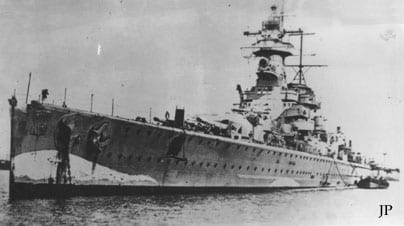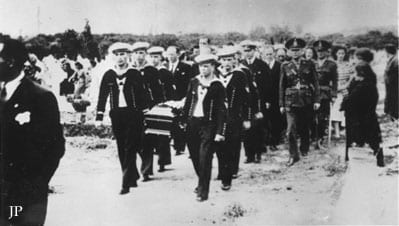Panzerschiffe Admiral Graf Spee
History |
 01 Oct 32: Laid down as Panzerschiffe C, although it was initially known as Ersatz Braunschweig. 01 Oct 32: Laid down as Panzerschiffe C, although it was initially known as Ersatz Braunschweig.30 June 34: Launched. 01 Jan 36: Commissioned into the Kriegsmarine at Wilhelmshaven as Panzerschiffe Admiral Graf Spee. Jan – May 36: Testing, training, and shooting trials. 09 May 36: Joined the rest of the German fleet and served as the fleet flagship. 29 May 36: Took part in the fleet parade at Kiel for the dedication of the naval memorial at Laboe. 06 June – 26 June 36: Training in the Atlantic, dropping anchor at Santa Cruz in the Canary Islands. 20 Aug – 09 Oct 36: Operations in Spanish waters. 13 Dec 36 – 14 Feb 37: Operations in Spanish waters. 02 Mar 37 – 06 May 37: Operations in Spanish waters. 15 May – 22 May 37: Took part in the Spithead Roadstead international naval review in British waters for the occasion of the coronation of George VI as King of England. 23 June – 07 Aug 37: Operations in Spanish waters. 18 Sept – 20 Sept 37: Cruise to Visby, Sweden. 01 Dec – 02 Dec 37: Cruise to Kristiansand, Norway. 7 Feb – 18 Feb 38: Operations in Spanish waters. 29 June – 09 July 38: Training cruise in Norwegian waters. 22 Aug 38: Took part in the fleet parade in Kiel Bay on the occasion of the state visit of Admiral von Horthy of Hungary. Discontinued service as the fleet flagship at this time. 06 Oct – 23 Oct 38: Training in Atlantic waters, making port at Vigo and Tangier. 10 Nov – 24 Nov 38: Training in Atlantic waters, making port at Bilbao. 22 Mar – 24 Mar 39: Took part in operations during the annexation of Memel. 18 Apr – 16 May 39: Service in Atlantic waters on naval manuversalong with Panzerschiffe Deutschland, Panzerschiffe Admiral Scheer,Kruizer Leipzig, Kruizer Koln, a Zerstorer, a Uboat tender,and various submarine flotillas. Made port at Ceuta and Lisbon. 30 May 39: Along with Panzerschiffe Admiral Scheer, Aviso Hamburg,3 Zerstorer, and a number of Torpedoboots, Graf Spee escorted the transport fleet of the Legion Condor arriving from Spain. The transport fleet consisted of the ships Wilhelm Gustloff, Robert Ley, Der Deutsche, Stuttgart, Sierra Cordoba, and the Oceana. The ships were escorted into the harbor at Hamburg. 21 Aug 39: Left Wilhelmshaven for South Atlantic waters. 11 Sept – 25 Sept 39: Held in a waiting position more than 900 miles east of Bahia. 26 Sept 39: Released for operations against Allied merchant shipping in the South Atlantic and Indian Oceans. 30 Sept 39: Graf Spee finds and sinks its first victim, the British freighter Clement (5051 BRT) while off of Pernambuco in South America. Oct 39: In the steamship lane in the Atlantic between Capetown -Freetown. 05 Oct 39: The British freighter Newton Beach (4651 BRT) is stopped and occupied by the crew from the Graf Spee. 07 Oct 39: The British freighter Ashlea (4222 BRT) is stopped and sunk. 08 Oct 39: The Newton Beach (see above) is sunk. 10 Oct 39: The British freighter Huntsman (8196 BRT) is stopped and occupied by the crew from the Graf Spee. 17 Oct 39: The Huntsman (see above) is sunk. 22 Oct 39: The British motor ship Trevanion (5299 BRT) is stopped and sunk. 04 Nov – 19 Nov 39: The Graf Spee moved into the Indian Ocean. 15 Nov 39: The British motor tanker Africa Shell (706 BRT) is stopped and sunk. Dec 39: Graff Spee returns to its earlier operations area in the middle Atlantic sea lanes. 02 Dec 39: Sinks the British freight steamer Doric Star (10,086 BRT). 03 Dec 39: Sinks the British refrigerator ship Tairoa (7983 BRT). 06 Dec 39: Graf Spee meets the German supply ship Altmark at 25.5 degrees south, 24.5 degrees west. The Graf Spee had met the Altmark 9 times to refuel, and this was its last meeting with the ship. Also at this time, the Graf Speeheads towards La Plata off of Uruguay to hide its intention of actually heading back to Germany. 07 Dec 39: The Graf Spee sinks the British freight steamer Streansalh (3895 BRT). 13 Dec 39: The Graf Spee ran into the cruiser pack of the BritishSouth American Squadron, consisting of the Heavy Cruiser Exeter, and the Light Cruisers Ajax and Achilles. The result of this meeting is known as the epic Battle of the River Plate. The fight took place in the La Plata estuary off the coast of Montevideo, Uruguay in South America. The Graf Spee put the Exeter out of action, and seriously damaged the Ajax, while only lightly damaging the Achilles. The Graf Spee received a number of hits during the battle and was forced to take refuge in Montevideo for repairs – International law allowed ships to take refuge in neutral harbors for repairs for a maximum limit of 24 hours, depending on the wishes of the neutral host. 14 Dec 39: Uruguayan authorities board the Graf Spee to assess the amount of damage the ship received, to decide if the ship would be allowed to stay in their neutral harbor for more than the 24-hour maximum allowed by international law. 15 Dec 39: After looking over the evidence gathered on the 14th, and after serious consideration of all the suggestions from the Americans, French, Germans, and British, a Presidential decree was declared stating that the Graf Spee would be allowed 72 hours to make any and all repairs. The time limit would end at 8:00 pm on the 17th of December, 1939. Also on the 15th, 320 crew members in full uniform were allowed to land and bury the Graf Spee’s dead. In attendance was the ship’s captain as well. 17 Dec 39: Unable to complete repairs of the Graf Spee within the allotted time, unable to dash across the harbor to Argentina, under strict orders by OKM not to go into internment in Uruguay, and wishing to avoid being taken by the British ships waiting and arriving in the region, Kpt.z.S. Langsdorff ordered his ship outside the harbor of Montevideo and to prepare to be scuttled. The ship’s crew were transferred to the German merchant ship Tacoma, and later to various Argentine tugs – all of which were soon after interned by Uruguayan authorities. Interestingly enough, the crew was under orders not to be interned in Uruguay, so with the permission of the Uruguayan authorities, they were transferred to Argentina, which was not under British influence and pressure as was Uruguay, and they spent the rest of the war there. Just after sunset, the Graf Spee was blown up with a series of well-placed charges, causing it to sink in shallow water, coming to rest on the soft bottom in plain view of the coast. TheGraf Spee sank intact and rested on the bottom with much of the ship still above the waterline. 19 Dec – 20 Dec 39: Kpt.z.S. Hans Langsdorf, while in his room in the Naval Arsenal in Buenos Aires where the ship’s officers were being held, committed suicide with a shot to the head. He was found the morning of the 20th wrapped in the ensign of his ship. He was later buried in the Cementerio del Norte in Buenos Aires – his final resting place. 1948: The Graf Spee, still in the place where it had been scuttled in 1939, had now sunk into the mud so that only its foretop was visible. Today: The faint remains of the ship can still be seen in the shallow water and mud where it was scuttled in 1939.  |
Commanders |
| Kpt.z.S. Konrad Patzig 1.06.36 – 1937 Kpt.z.S. Walter Warzecha 1937 – 1938 Kpt.z.S. Hans Langsdorff 1938 – 12.17.39 |
